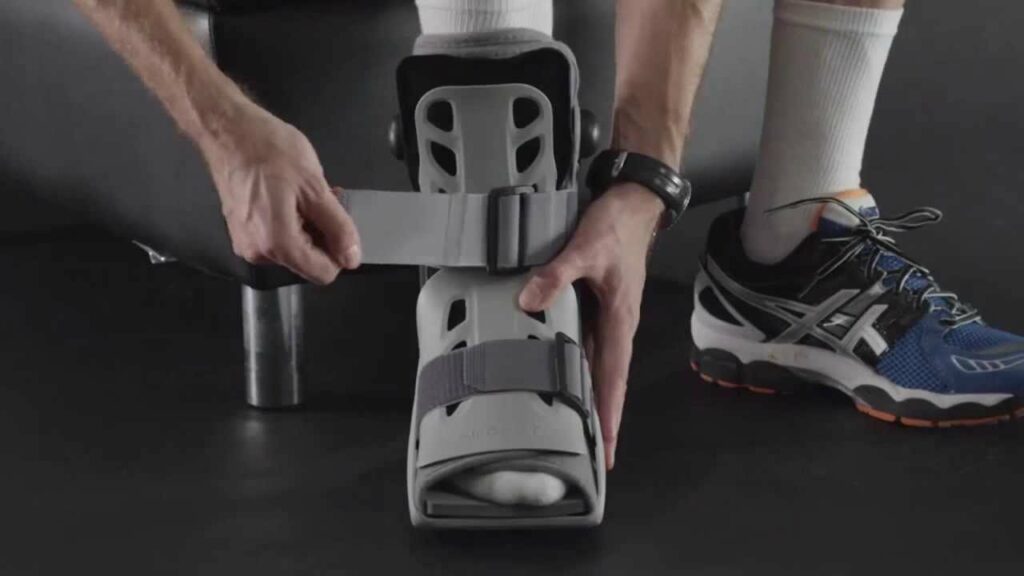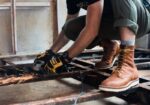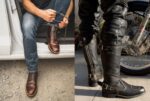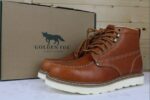Walking boots are no doubt comfortable and it does provide support to your feet. When we have a foot injury, we are usually told to wear a walking boot.

The question that puts people in a dilemma is whether it should be worn at night while sleeping or not. Because foot injuries are so critical, you must be sure to follow the right procedures.
If you can spare a few minutes reading this, it will legit explain all you need to know about walking boots and when to wear them.
If you’re using walking boots for treatment of a foot fracture or injury, you should keep them on at night in the first few weeks. You can only take them off when you’re in the shower. If it is too uncomfortable, try loosening the straps.
Reasons you need to wear a walking boot to bed
1. Keeps the foot in place and prevents further damage
When you’re asleep, your body goes into hibernation mode, relaxing all of your muscles, which increases the risk of aggravating your foot injury because you might forget that you have an injured foot. You are usually unaware of where your foot is moving when sleeping.
Even if this possibility is ruled out, you can still exert pressure on your feet unknowingly and subconsciously as you’re not in control of your body. You are usually unaware of your body rolling over while sleeping.
Your ankle will not be active if you do not use walking boots. It will be resting in an elevated and pointed position, which might be a hindrance to your recovery.
2. The boots acts as a subtle reminder
Our brain functions in a magical way, especially our subconscious part. I’m sure I speak for most of us when I say there have been times we all have been up before the alarm even went off. Wonder why? That’s our subconscious mind working.
In the same way, the heaviness of the boot acts as a gentle reminder that you have a foot injury and you need to be careful about it. It is like giving your body an extra warning to keep your foot safe.
3. When is it advisable for you to wear walking boot
Well the first thing to remember is ‘What does your doctor say?’
Because that’s the first person you should be asking.
Many doctors recommend removing the boot at night to allow the foot to breathe more easily. If you had to get up for whatever reason, you would be expected to put it on. Others want it to stay on the whole night in order to keep proper alignment of your injured foot.
It was previously mentioned that sleeping in your boots is really beneficial. It’s fine if you want to take them off at night for a bit. Taking them off completely, though, isn’t the best solution.
Some folks don’t mind taking off their boots at night and sleeping peacefully. As a result, it varies from person to person and the severity of their injuries.
How long should you use walking boots?
Well generally, it is advisable to wear walking boots for about 1-6 weeks and that totally depends on the intensity of your injury. Look at the following chart for your understanding:
| Number of weeks | Advice |
| 0-6 weeks |
|
| 6- 8 weeks |
|
| 8-12 weeks |
|
| 12th week |
|
Issues that can occur while wearing walking boots
1. Your feet will be exhausted
Your feet need to breathe. Covering them with layers of socks and shoes will not allow them to breathe properly which will eventually cause them to stink.
2. Your sheets might get dirty
If you have to keep it on even while you’re sleeping, make sure to cover it with an ace bandage or a sock large enough to cover the boots so that your sheets are protected.
Imagine walking around everywhere with the boots and having to bring them with you to bed, gross right?
3. Can lead to inflamed ligaments
Having to wear boots for 24 hours can have its drawbacks. It can lead to certain issues like inflamed ligaments and tensed tendons creating a throbbing and cramping pain on your foot.
4. Causes discomfort
Wearing your walking boots for the past two days and not being able to take them off even once is no doubt unsettling. Plus the itching that comes and goes, is beyond the level of discomfort.
If these drawbacks concern you, we’ll provide solutions for it too. Here are some tips you can follow to make your experience with walking boots hassle free while sleeping.
5. Loosen the strap
The first step to assuring your boots’ comfort is to adjust the straps, as you cannot sleep in a boot that is too tight.
Also, if your boot is securely strapped in, blood flow in your foot is obstructed, which might make your foot suffer in the morning. Your difficulty will be alleviated by loosening them an inch or so.
6. Use a gel heel cap
Since the heel is one of the most sensitive areas of your foot, you may believe that the pain is centred there. So cushioning your heel can help you feel better. Because it has no adverse effects, it is much better than medication.
Scholl’s Massaging Gel Heel Cups gives support to your heels, and adds a layer of cushioning to absorb shock from working on hard surfaces, reducing muscle fatigue, tiredness, sore feet, and heel pain.
- Designed in conjunction with athletic trainers to help prevent and relieve heel pain during sport activity
- Incorporates proprietary Massaging Wave System to provide maximum shock absorption
- Lightweight, gel construction provides stability and support
- Enables the cups to fit comfortably into any type of shoe
Prices pulled from the Amazon Product Advertising API on:
Product prices and availability are accurate as of the date/time indicated and are subject to change. Any price and availability information displayed on [relevant Amazon Site(s), as applicable] at the time of purchase will apply to the purchase of this product.
7. Make use of a pillow
We all must have encountered that a pillow is placed under the foot of an injured person. Well, it is a helpful trick to reduce pain and discomfort. This way your foot is raised above your heart and there is no obstruction in the blood flow which further prevents your foot from swelling.
Points to make sure of
If you do decide to remove your walking boot, make sure you prevent any form of foot movement. Simply sit back and relax while putting as little strain on your foot as possible.
In this circumstance, a pillow will come in handy. Take a pad and place it under your sore foot to elevate it slightly.
This will not only assist you medically, but it will also keep you aware that your foot is wounded and that you must be careful.
Transitional period (From walking boot to regular shoes)
As thrilling as it is to finally be free of the walking boot, another foot injury is the last thing you need. You should be aware that because your foot is more fragile and sensitive than usual, it will most likely require longer time.
It’s possible that you’ve been using your walking boots for a month to three months. The transitional period from your walking boots to regular shoes is crucial as you need to give yourself some time to adjust.
You’ll need to start two to three months of rehabilitation or physiotherapy once you’ve started transitioning out of the walking boot. The basic goal of therapy is to get your foot and ankle back to normal strength and motion.
Here is a chart for you to understand the transitional period better, however, you shouldn’t ignore your doctor’s advice.
| Time period | Advice |
| Day 1 to 10 | Take off the walking boot for an hour in the morning and afternoon. |
| Day 11 to 21 | Take off the walking boot for two hours in the morning and two hours in the afternoon. |
| Day 22 to 33 | You can remove the walking boot for three hours in the morning and three hours in the afternoon. |
| Day 34 to 42 | Remove the walking boot for four hours in the morning and four hours in the afternoon. |
| 7th week onwards | You can now remove the walking boot completely. |
Although it is important that you use the boots suggested by your doctor, you can look into the possibilities below if you wish to conduct your own market research.
Now let us get into some recommended footwear that we have created to ease up your workload.
1. BraceAbility Post-Op Shoe For Broken Foot Or Toe
- Can be worn on your right or left foot. Large Male weighs 13 ounces.
- Non-slip traction on the rubber sole provides extra stability after surgeries for broken toes, bunions, hammer toes, Plantar fasciitis, etc.
- INNOVATIVE STRAPPING & SQUARE-TOE DESIGN
- COMFORTABLE IMMOBILIZATION
- POST SURGICAL PROTECTION
Prices pulled from the Amazon Product Advertising API on:
Product prices and availability are accurate as of the date/time indicated and are subject to change. Any price and availability information displayed on [relevant Amazon Site(s), as applicable] at the time of purchase will apply to the purchase of this product.
This footwear is best designed for post-surgical recovery, toe sores, broken toes, and ulcerations. These are also ideal for damp and cold weather.
2. Orthotronix Closed-Toe Short Air Cam Walker Boot
- Closed-Toe Air Walker Boot designed to support and protect your foot.
- Fully-integrated inflatable air liner.
- Ventilated panels and moisture wicking liner keep the skin dry & comfortable
- This closed toe design meets OSHA standards for the workplace, allowing you to get back to work faster.
- Quick release and easy to manage fastening straps for a secure yet easy fit.
Prices pulled from the Amazon Product Advertising API on:
Product prices and availability are accurate as of the date/time indicated and are subject to change. Any price and availability information displayed on [relevant Amazon Site(s), as applicable] at the time of purchase will apply to the purchase of this product.
Mild ankle sprains, heel sprains, and fractures are the most common reasons for wearing these boots. The customized inflated air cells keep your foot in the right place. As a result, they provide more stability.
3. ExoArmor Ultralight Walking Boot
- This ExoArmor Ultralight Walking Boot is ideal for a Sprained Ankle, Stress Fracture, Broken Foot or Achilles Tendonitis.
- Walking fatigue is reduced with our lightweight polypropylene construction.
- Our walking boot provides orthopedic protection on all sides of the ankle and leg.
Prices pulled from the Amazon Product Advertising API on:
Product prices and availability are accurate as of the date/time indicated and are subject to change. Any price and availability information displayed on [relevant Amazon Site(s), as applicable] at the time of purchase will apply to the purchase of this product.
This lightweight walking boot is ideal for an ankle fracture, achilles tendon injury, stress fracture, sprained ankle, broken foot or broken toe.
Some FAQs to ponder upon:
What should be expected once your walking boot is removed?
After removing your walking boot, it’s common for your foot to feel unusual, especially if you’ve been wearing it for months.
Aside from being wrinkled and pale, there’s a good possibility your foot is swollen and stiffer than usual. You will immediately feel lighter and find it much easier to manage once you remove the walking boot.
Conclusion
You should understand that foot injury is a serious issue and should not be taken lightly. And your doctor will advise you on the best course of action. In the majority of cases, it is better to follow them.
You can take a break from wearing boots every now and then. However, for the first few weeks, don’t even consider it.











